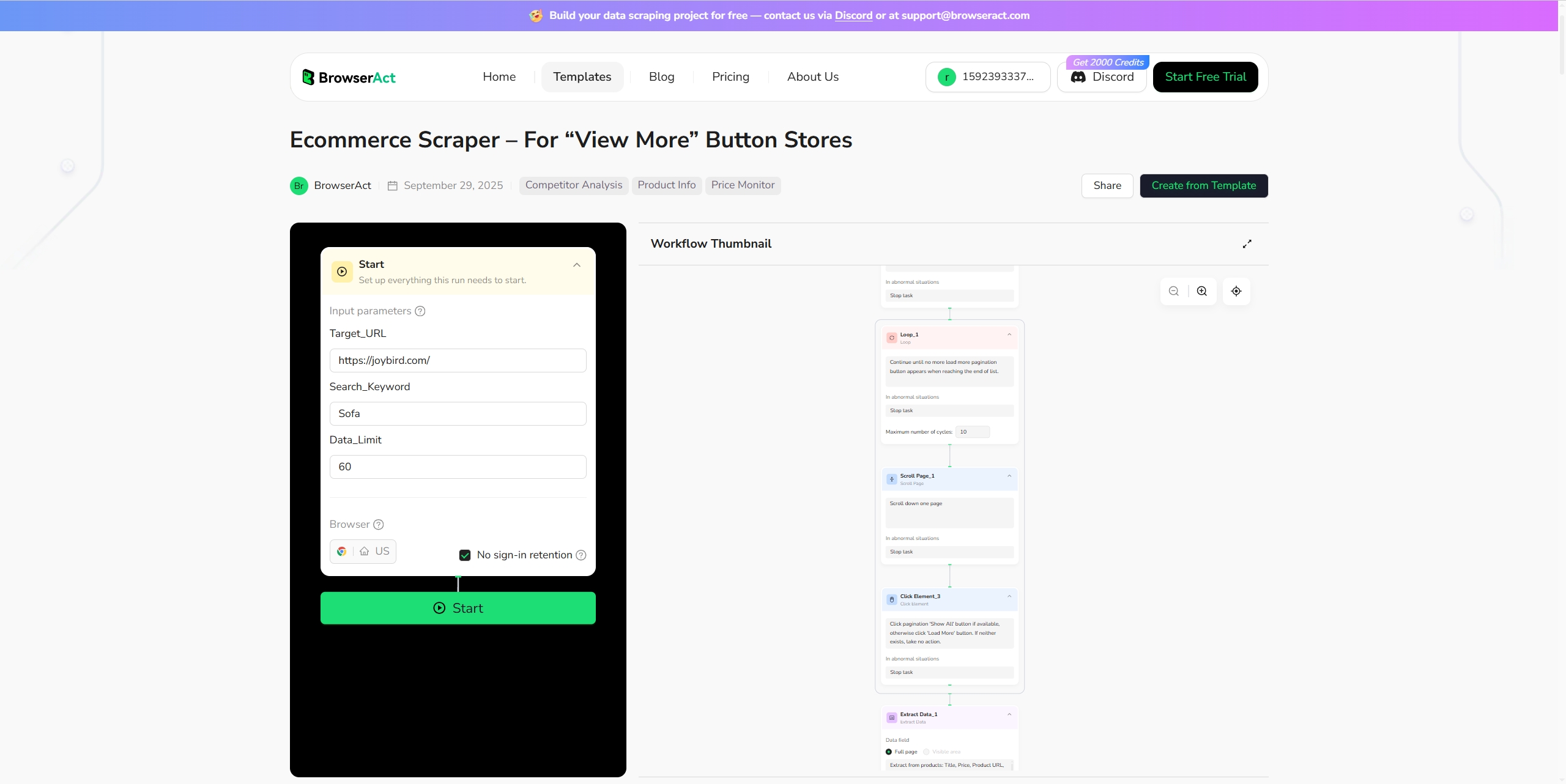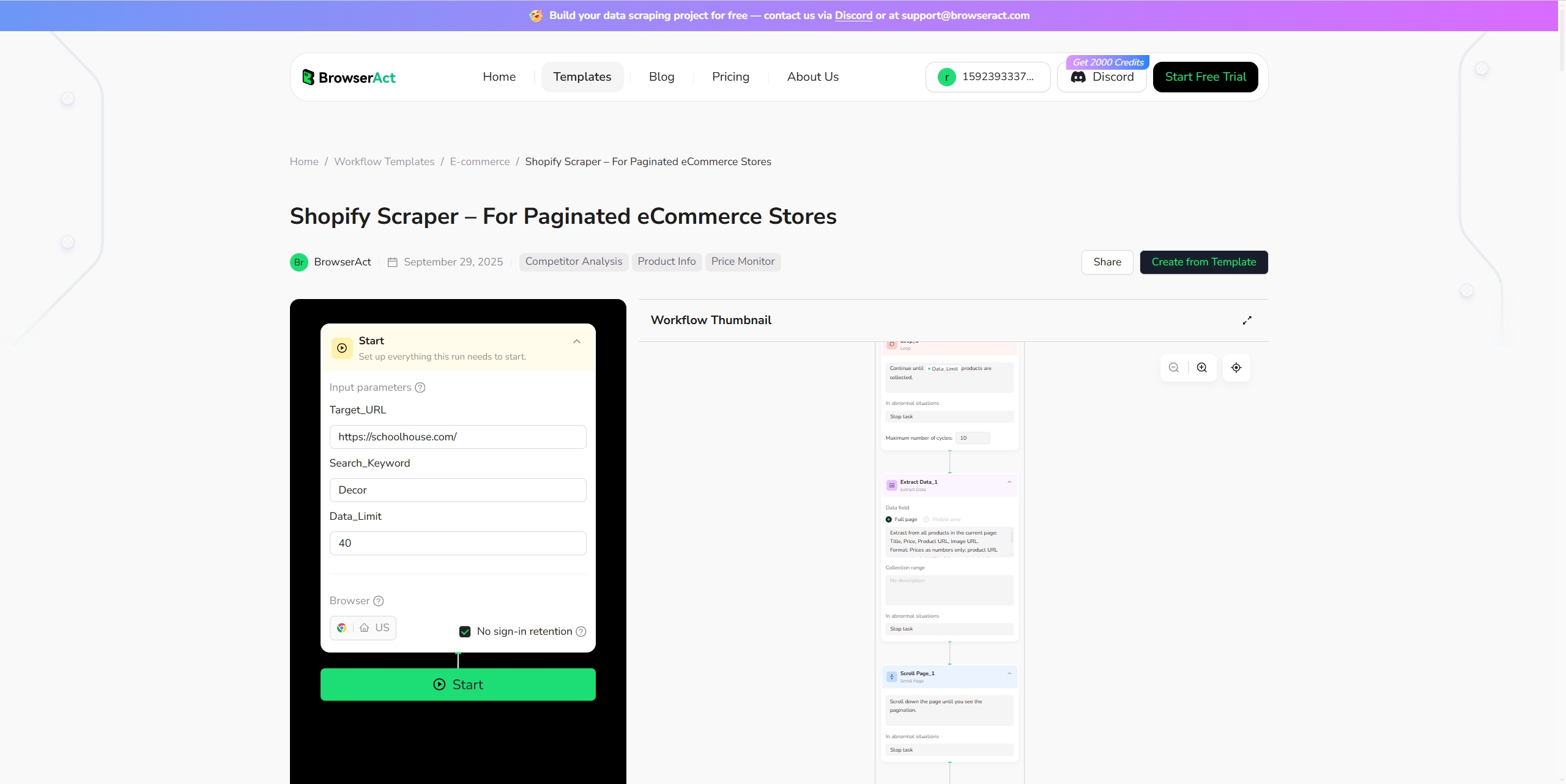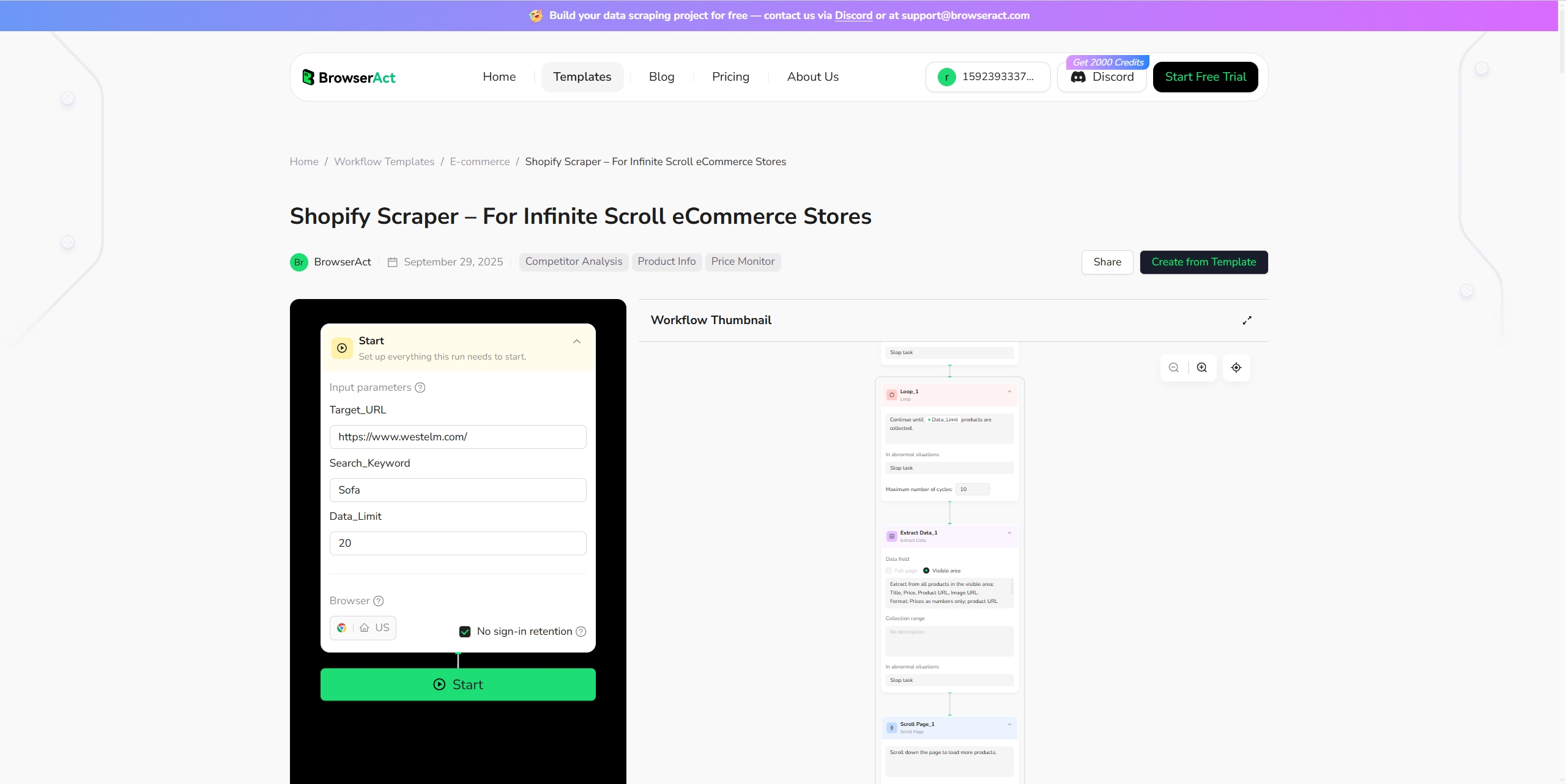BrowserAct Shopify Product Scrapers — Data Collection for Every Store

The BrowserAct Shopify Product Scrapers implifies this process by collecting complete, accurate product data automatically. With three purpose‑built workflows for different Shopify layouts, teams can easily perform price tracking, competitor analysis, product research, and market intelligence without coding or manual effort. Whether you’re a seller, marketer, or analyst, BrowserAct helps you turn raw Shopify data into actionable insights — faster, cleaner, and smarter.
Running a Shopify business means juggling thousands of details — prices change, products move, and data piles up fast. The hardest part isn’t selling; it’s keeping your product data accurate and complete.
BrowserAct Shopify Product Scrapers helps you cut through that noise. It automatically collects every product — even from tricky layouts with “View More” buttons, multiple pages, or endless scrolling — and turns everything into clean, usable data you can trust.
The Hidden Challenge Behind Every Shopify Role
Every Shopify professional has their own priorities — growing sales, improving visibility, or staying ahead of competitors — yet they often face the same hidden challenge: getting reliable, up‑to‑date product data quickly and accurately. Whether you’re a seller, marketer, analyst, or researcher, manual scraping and fragmented data processes can slow everything down. Let’s take a closer look at what each group struggles with — and why automation is the light at the end of this tunnel.
- For Shopify Sellers — “I’m drowning in clicks and spreadsheets.”
Running a Shopify store means managing hundreds (sometimes thousands) of SKUs, supplier updates, and competitor checks — all while trying to scale your brand.
Their real challenges:
- Endless clicking just to load products. Many stores hide listings behind “View More” buttons or multi‑page structures, forcing sellers to spend hours navigating instead of selling.
- Price and inventory changes that happen too fast. Suppliers update prices daily, but manual checks can’t keep up — leading to outdated listings or lost margins.
- Inconsistent product data sources. Different vendors and marketplaces format data differently, creating chaos in catalog updates.
- Limited time and tools. Most sellers aren’t tech experts; building or maintaining a scraper feels impossible.
- For Marketers — “I can’t make smart pricing decisions without real data.”
In today’s fast‑changing retail landscape, marketers rely on live product and price data to adjust campaigns, track competitors, and measure brand presence. But most still depend on manual data research or delayed reports.
Common frustrations:
- Blind spots in competitor monitoring. Many Shopify stores use different layouts, meaning a single scraping method can’t capture them all.
- Slow campaign reaction. When product or price changes go unnoticed, ads promote outdated offers — wasting budget and credibility.
- Fragmented insights. Valuable pricing and positioning data stays isolated in different files or tools, never forming the full picture.
- Manual effort ≠ market speed. In competitive categories like fashion or groceries, timing is everything — not hours of manual tracking.
- For Analysts & Data Teams — “My data looks good... until I look closer.”
Analysts need clean, consistent, and complete datasets to deliver trustworthy insights. But scraping data from modern, dynamic Shopify stores is more complex than it seems — and makes data cleansing a full‑time job.
Key challenges include:
- Data gaps and duplicate entries. Different store structures (pagination, load buttons, infinite scroll) often produce partial datasets.
- Time lost to data cleaning. Hours that could go to analysis are spent fixing missing fields or formatting inconsistencies.
- Scalability limits. Tracking hundreds of Shopify stores or thousands of SKUs manually just doesn’t scale.
- File chaos. Multiple CSVs, different column names, mismatched currencies — analysts spend more time merging than analyzing.
- For Researchers & Product Teams — “I have insights to find, not buttons to click.”
Researchers studying pricing models, assortment trends, or consumer product data often face endless browsing and partial results. When each store behaves differently, collecting comprehensive datasets feels impossible.
Typical hurdles:
- Infinite scroll and AJAX loading. Some stores literally never “end,” making copy‑paste or standard scraping tools useless.
- Irregular product displays. Collections shift dynamically, and manual scrolling can still miss hundreds of products.
- Time drain. Valuable research time disappears in data gathering instead of interpretation.
- Data inconsistency across samples. When datasets don’t match in depth or accuracy, conclusions lose credibility.
Despite different job titles, everyone using Shopify shares one bottleneck — data collection that’s still too manual, slow, and inconsistent. And as catalogs, competitors, and supply chains expand, that bottleneck grows tighter.
That’s why the BrowserAct Shopify Scrapers exists: three complementary, no‑code workflows that handle “View More” buttons, paginated layouts, and infinite scroll pages — automatically. No scripts. No missed listings. Just clean, complete Shopify data, delivered in the format you need, at the speed your business demands.
Three Workflows, One Complete Solution
1️⃣ BrowserAct eCommerce Scraper — For “View More” Button Stores
Shopify stores that hide products behind “View More” or “Load More” buttons make data collection time‑consuming and unreliable. Manually expanding these sections drains hours and often results in missing listings — a major issue for anyone running a price tracker or product research workflow.
This scraper automatically detects and clicks “View More” buttons until the complete product list is visible. Then it extracts structured data — titles, prices, URLs, and images — without any manual work.
💎 Value to Users
- Saves hours spent on repetitive clicks.
- Ensures full product coverage and precise data capture.
- Ideal for anyone building a market intelligence dashboard or maintaining a competitive pricing monitor.
- Enables reliable product research and vendor comparison at scale.

2️⃣ BrowserAct Shopify Scraper — For Paginated Stores
Many Shopify stores still rely on classic pagination, spreading products across several pages. Manually clicking and copying each page is inefficient and inconsistent — especially when you’re doing market intelligence or competitor monitoring.
The scraper navigates through all catalog pages automatically, capturing titles, prices, and image links. It then merges everything into a clean, standardized dataset, perfect for analysis or integration into price monitoring tools.
💎 Value to Users
- Automates full-page coverage — ensuring 100% product collection.
- Provides consistent, structured outputs across every store page.
- Perfect for eCommerce analysts, price tracker tools, and market research reports.
- Great foundation for data visualization dashboards and trend forecasting.

3️⃣ BrowserAct Shopify Scraper — For Infinite Scroll Stores
Infinite‑scroll and AJAX‑based Shopify stores continuously load products as users browse — a challenge that breaks most traditional scrapers and makes manual market intelligence nearly impossible.
BrowserAct’s smart automation scrolls dynamically until all products load, then systematically collects structured data (name, URL, price, image). Every product, every time — no interruptions.
💎 Value to Users
- Handles real-time product monitoring effortlessly.
- Captures complete, scalable datasets across even the largest stores.
- Empowers dynamic price tracking systems and market intelligence tools.
- Ideal for data scientists building models for automated pricing optimization or trend detection.

Use Cases
Retailers Refreshing Their Product Master Lists for Pricing Updates
Retailers constantly battle changing supplier prices, dynamic discounts, and stock rotations. Using this scraper, teams can automatically generate complete, real‑time product master lists — including prices, SKUs, and product images. This eliminates the manual effort of updating pricing sheets and ensures pricing accuracy across all sales channels. Combined with a price tracker or market intelligence dashboard, retailers gain a live view of their product landscape and maintain consistent, competitive pricing across eCommerce platforms.
Research Teams Building SKU or Price Tracker Databases
For research analysts and data teams, accurate datasets are everything. Manual collection often leads to missing items and outdated data — especially across stores that use different layouts. BrowserAct’s scraper automatically gathers product information from any Shopify store, generating structured, ready‑to‑analyze data for price tracker systems or product research databases. This enables researchers to quickly identify pricing trends, stock patterns, and emerging product categories — valuable insights that power market intelligence tools and strategic reports.
Brand Managers Conducting Multi‑Store Competitor Analysis
Brand and category managers need to know exactly how competitors price, position, and update their products across multiple Shopify sites. With BrowserAct, they can automate multi‑store competitor analysis, comparing catalog depth, pricing tiers, and product images across dozens of retailers at once. These insights feed directly into pricing optimization, assortment planning, and campaign benchmarking, helping brands stay one step ahead in every market segment.
Agencies and Consultants Delivering eCommerce Market Intelligence
For agencies running multiple client accounts or conducting regional retail analysis, BrowserAct simplifies data operations. Teams can monitor product collections, promotions, and pricing shifts — turning raw scraping output into actionable market intelligence. No coding, no manual refreshes — just live, structured eCommerce data that supports competitive positioning, pricing strategy, and product performance analysis.
AI & Data Science Teams Training Pricing or Recommendation Models
Machine learning professionals rely on diverse, clean datasets to train models accurately. Automating Shopify data collection provides consistent product details — titles, prices, URLs, and images — across dozens of merchants. This accelerates the development of AI‑driven price tracker applications, demand forecasting, and intelligent product recommendation systems, all powered by structured, high‑integrity data.
In eCommerce, good decisions start with good data. BrowserAct makes sure every team — from sellers to analysts — works from the same accurate, up‑to‑date information. It’s the simplest way to stay competitive, respond faster, and focus on growth instead of manual tasks.
Collect smarter. Understand faster. Grow with confidence — with BrowserAct.

Relative Resources

From Reviews to Strategy: Using Sentiment Analysis for Market Analysis and Product Research

Automate News Tracking and Content Updates with AI

Using Amazon Competitor & Review Sentiment Scraper to Outperform Rivals




